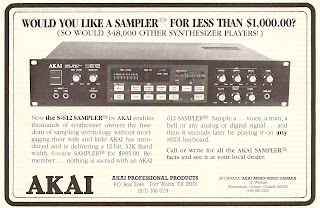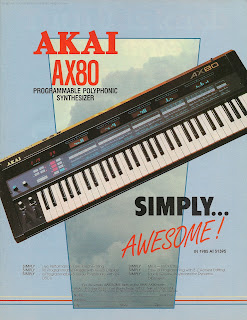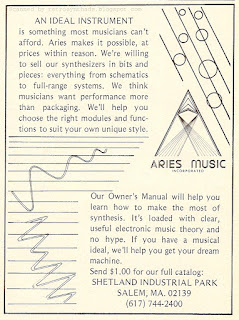Akai AX60 "Synth With A Split Personality" two-page introductory colour advertisement from page 14 and 15 in the January 1986 issue of Keyboard Magazine.
Akai ads are just getting bigger and better, and this two-page full colour advertisement for the AX60 just knocks my socks off. It had a rather good ad-run too, appearing for a number of months between January and April, and then making a brief appearance again in September 1986.
But, be warned. My objectivity may have taken a vacation today. So, full disclosure - I own an AX60 and I **LOVE** it. Yes, four **asterix** worth of **LOVE**.
It was one of the first synthesizers I bought off the Internet - from a cool dude in the Analog Heaven email list. I can recall the excitement of the transaction, the anxiety of waiting for it to arrive, wrestling with shipping box when it finally did arrive, and sliding it out of the box to reveal this gorgeous beast for the first time.
Yum.
The best thing about this ad is the fact that the front panel of the synth takes up the whole bottom half of the two pages. You can clearly read every control. It's magnificent and gives readers a good indication of EXACTLY what they are purchasing.
A close second best thing about this ad is the inclusion of the $795.00 price tag.
And a close third best thing is its association with the S612 sampler. Up until now, the poor S612 has spent most of its time in half-page ads, usually in the back-half of Keyboard. But now at least it was getting a bit more air-time with its younger brother. These two peas in a pod even share similar markings, grays with a dash of pastel reds and blues.
One thing I hardly noticed in this ad at first was what I thought was a lightning bolt down the center of the two pages. But then I realized its the "split" in the "split personality" aspect of the ad. Ha!
There are many reasons to like this advertisement, but there are just as many reasons to love the synthesizer itself. All the controls are located on the front panel, it has an arpeggiator, you can split the keyboard to create two different sounds, I could go on and on...
But for me, the coolest feature of this synthesizer is the VCO MOD control in the VCF section. It makes this synth scream and burble and gargle and gack. The AX60 manual has this to say about it:
"This unique feature produces musically useful timbre shifts when moved; the action is similar to tone control, but more sophisticated."Yes, yes it truly does.
If you have not heard this sound, I've uploaded a simple arpeggiated saw wave demo to SoundCloud. Its a little distorted (caused by SoundCloud, not the VCO MOD function) so I've enabled the wave download button so you can download the original wave file (11 MB I think) if the audio gets to be too annoying.
Listening to the demo, you can really hear the harmonics/distortion added to the sound with this one simple slider interacting with the cut-off and resonance, and you can see why I used the VCO MOD *a lot* in angry songs I was created in the mid-late 90s. I would ride the slider up and down throughout some songs. :D
Like the ad, the manual also spends a a fair bit of time talking up the AX60's connection to the S-612 sampler. Six of the 43 pages to be exact, running through the basics of set up, editing sampled sounds, stereo effects, and using the AX60's keyboard split function with the sampler.
But it is the final section - 11F: A Word to Creative Musicians... - that seals the deal for me, and makes me reach for the eBay app on my new NEXUS 7 Google tablet to buy one (nope, didn't get paid by eBay or Google to say that, just wanted to brag):
"The AX60/S612 combination is a powerful one. It will take you some time to master using the two devices together, but practice makes perfect. After you become familiar with the system (maybe even before!), you will be able to produce some absolutely marvelous sounds."All this writing about the AX60 has me truly excited about this machine again. Now I gotta go play on it some more.
There goes the rest of my lovely afternoon.
Gah!



















